|
See More Information on Canning Vegetables and Fruits:
Canning Preparation | Canning Temperatures and Processing Times
Canning Methods | Canning Safety, Storage, and Tips
Canning Supplies | Canning Ingredients
Canning is the process used to preserve fruits and vegetables for long term shelf storage. If processed properly, this is a very safe method of preserving food. Canning is the process of placing food in jars and heating them to a temperature that will destroy micro-organisms that spoil the food. Through the canning process the jar is vacuum sealed so air cannot get in the container and cause contamination. There are two safe methods that can be used, boiling-water-bath and pressure canning. The type of food being canned will generally determine which method is used. The information below plus the additional topics shown above should provide you with what you need to know to safely preserve your fruits and vegetables through the process of canning.
Canning Supplies
| Boiling-Water-Bath Canner w/Lid |
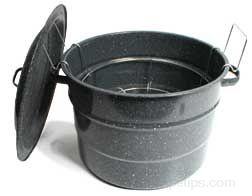
|
|
A large pot with a lid generally made of aluminum or porcelain-covered steel, which is used for canning high-acid foods. There are also canners available made from stainless steel that are very durable but also more expensive. Common sizes are 21 and 33 quart canners, which include a lid and jar rack. Boiling-water-bath canners are available with bottoms that are flat or ridged. Either type can be used on a gas burner but if using an electric burner, the bottom of the canner must be flat to provide uniform heating throughout processing. The diameter of the canner should not be more than 4 inches larger than the burner so that that the canner does not hang over the burner more than 2 inches on all sides. |
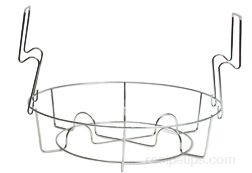
|
|
Rack for Boiling-Water-Bath Canner
The removable rack in a boiling-water-bath canner is generally a molded wire rack designed to hold the jars up off the bottom of the canner and separates the jars so that they do not hit each other during processing. Some racks can also be made of wood. The rack is also designed so the water can move freely around and under the jars, which provides for even processing. |
If a canner is not available, any large pot with a lid can be used as long as it is deep enough to allow 4 inches above the jars when processing so that the jars are covered by 2 inches of water and there is 2 inches of boiling space. A wire rack must be used on the bottom to keep the jars up off the direct heat of the burner. Towels can be wrapped around and in between jars to prevent them from hitting each other and causing breakage during processing. |
Pressure Canner |
|
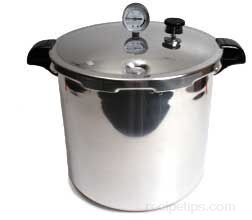
|
|
Pressure canners must be used when processing low-acid foods. They can also be used for processing high-acid foods but the total processing, from the time to heat the water to a boil, vent and pressurize the canner, process the jars, and cool the canner before removing the jars, is so long that most people prefer to use the boiling-water-bath canner because the total processing is much shorter. It only involves bringing the water to a boil, processing the jars, and then removing the jars from the canner. The jars do not have to cool in the canner with the boiling-water bath method.
|
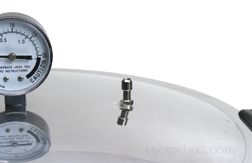
Vent or Pet-cock |
|
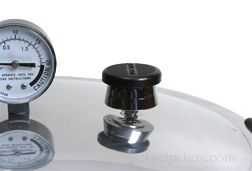
Weighted Regulator |
Vent or Pet-cock: A pressure canner is a heavy pot that has a lid that can be sealed tightly and contains a safety fuse, a vent (referred to as a pet-cock), and a weighted or dial gauge to regulate the pressure in the canner during the processing time. The vent or pet-cock is a small hollow pipe that sticks out of the lid and when left open, it allows steam to escape from the pot. When closed it allows pressure to build inside of the pot. The opening and closing of the vent is controlled by a weighted regulator on newer model canners and older models the opening and closing of the valve is controlled by adjusting a valve. |
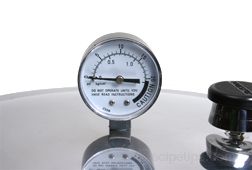 |
|
Dial Gauge: The lid of a dial gauge canner will have a counterweight or pressure regulator that seals the vent port to pressurize the canner. This regulator does not jiggle or rock to maintain pressure. The pressure is measured on the dial gauge and then adjusted accordingly. A dial gauge canner should have the gauge checked for accuracy each year before using. This can normally be done by your local Cooperative Extension office. |
Weighted Gauge: A weighted gauge regulates the pressure of a pressure canner very accurately and does not have to be checked each year for accuracy. The gauge is designed to jiggles a number of times a minute or rock gently to maintain the right amount of pressure. |
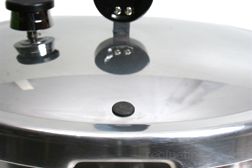 |
|
Overpressure Plug: This plug is a safety device that will automatically pop up and release steam if for some reason the vent pipe would become plugged and was unable to release the steam as it normally would. |
Sealing gasket: Many pressure canners have a gasket around the edge of the cover that prevents steam from leaking, allowing the lid to seal tightly to the canner. The gasket is a rubber-like compound that can be removed for easy cleaning. Not all pressure canners use a gasket. |
|
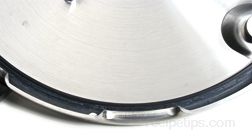 |
 |
|
 |
Vent/Cover Lock: Some models have an extra lock on them for added safety. The vent lock automatically exhausts air as the pressure builds and the tube rises up on the cover. This acts as a visual indication that the pressure is building and as the tube raises it engages with the locking bracket to lock the cover on the canner. |
|
Locking Bracket: The locking bracket is on the inside of the canner. As the tube of the vent/cover lock rises on the cover, it engages with the bracket forming a lock. The cover will not unlock until the pressure has been released from the canner, allowing the tube to lower and disengage from the locking bracket. It is then safe to remove the cover from the canner. |
Older model pressure canners were pots with heavy walls and lids that clamped on or turned on. Modern canners are now lighter weight with thinner walls and most have turn on lids with gaskets. All the canners contain a removable rack for holding the jars. Some canners are designed to hold quart size or smaller jars and some are designed to hold a double layer of pint size or smaller jars. |
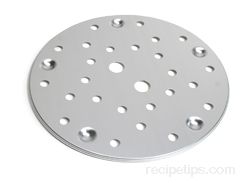 |
|
Rack for Pressure Canner
The pressure canner has a stainless steel perforated rack that sets in the bottom of the canner to hold the jars off the bottom and to allow water to flow under and around the jars. Some have two racks that can be used to hold two layers of pint size jars. Some pressure canners may have a molded wire rack similar to the one used in the boiling-water-bath canner. |
|
A pressure canner can also be used for boiling-water-bath canning as long as there is enough airspace at the top for the heavily boiling water. The cover should not be fastened to the canner and the vent on the cover should be left open so that too much pressure does not build up in the canner.
Note: Be sure to read the instruction manual for the pressure canner you are using. Each type of pressure canner may have specific instructions for operating safely. |
Canning Jars

|
|
The best types of jars to use for canning are the kinds that are made specifically for home canning. They are available in varying sizes from 1/2 pint to 2 gallon. The most popular jars for canning are the half pint, pint and quart size. These sizes work well in most standard canners. The jars are also available in regular mouth, which is approximately 2 3/8 inches in diameter, and wide mouth, which are approximately 3 inches in diameter. The wide mouth is used when canning whole or larger fruits and vegetables, such as peaches and cucumbers. Check your recipe for any special jar size requirements before you get started preparing the jars. Canning jars can be used an endless number of times but just be sure to carefully check the rim of the jars for cracks or chips, which would cause the jar to not seal.
|
| Note: Whatever size or type of jars are used for canning, they must be at least 4 inches shorter that the canner to allow 2 inches of water to cover the jars and 2 inches of boiling space. |
Other Canning containers: Commercial mayonnaise or salad dressing jars can be used for canning but it is not recommended because you run a higher risk of the jars breaking during processing and not sealing properly. Antique jars that have rubber rings and porcelain-lined zinc caps, and antique jars with bailed-wire seals run a high risk of not sealing properly and should be used for short term or dry storage only. |
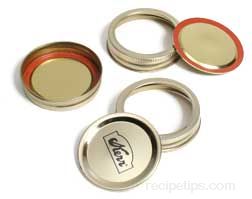
|
|
Lids and Rings
The cover used on canning jars during processing consists of a lid and a screw ring. The lid has a sealing compound around the outer edge that softens during processing and then seals tightly to the rim of the jar when completely cooled. The lid is held in place by the screw ring during processing and then once the jars have completely cooled, the rings are removed. If the ring does not come off easily, do not force it off because the seal could break. Also, do not tighten the ring once the jar has been processed to avoid the risk of breaking the seal. |
The rings can be used over and over again as long as they show no sign of rust. If they have started to rust, the rings should be discarded. The lids cannot be reused. New lids have a shelf life of approximately 5 years from the manufacture date. |
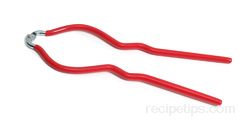 |
|
Canning Tongs
Canning tongs are specially designed so that the end will fit securely around the neck of the jar to aid in removing it from the hot canning water. |
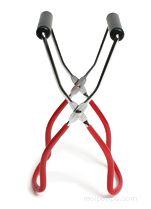 |
|
Jar Lifter
The jar lifter is used for the same purpose as the canning tongs. They are used to remove the hot jars from the canning water. The ends fit up tightly around the neck of the jar, making it easier to remove from the canner. |
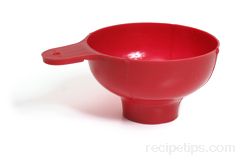 |
|
Canning Funnel
A canning funnel fits into the opening of the jar and allows food to be added without getting food on the rim. The funnel is generally made of stainless steel or plastic and is shaped so that it will fit into a regular or wide-mouth jar. |
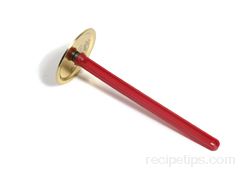 |
|
Lid Wand
Lid wands are used to remove the hot lids from the simmering water. The wand is magnetized so the lids stick to the wand and can be lifted out of the hot water just before placing on the jars. |
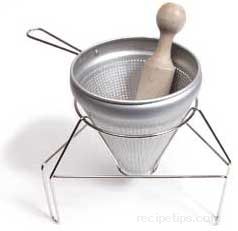 |
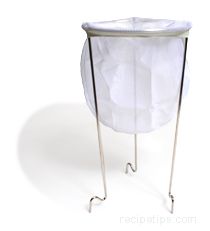 |
| Chinois Strainer |
Jelly Strainer | |
|
Strainers
Chinois Strainer: A tool that is used to remove skins and seeds from fruits and vegetables by pressing them through the strainer with a pestle. A regular sieve or food mill could also be used.
Jelly Strainer: A type of strainer used for the preparation of jellies and sauces. This utensil is a common tool when canning various types of foods. There are several variations of design for the Jelly Strainer, but most all include a fine mesh, nylon filter bag. The mesh bag strains out excess materials so the result is a very clear mixture, such as is desired for jelly or a clear sauce. |
 |
|
Timer
It is very important that an accurate timer is used so that the processing times can be watched closely. The timer can be a stand alone timer, the timer on the stove, or it could be a wall clock if watched carefully. |
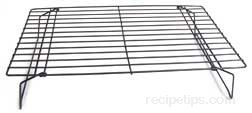
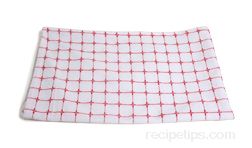 |
|
Cooling Rack or Dish/Tea Towels
When the food is done being processed, the jars are removed from the canner and should be set aside to cool. They can be set on a cooling rack or they can be set on a dish towel or tea towel when removed from the canner. The jars should be placed with some space in between them so the air can circulate around them to cool faster.
A clean dish towel also works great for wiping anything off the rim of the jar before placing the lid on it. |
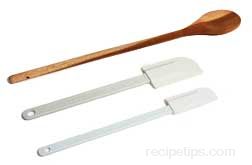 |
|
Non-Metallic Utensil
A non-metallic spatula or another non-metallic utensil, such as a wooden chopstick or the end of a wooden spoon, is needed to press out the air bubbles once the jars are filled. A metal utensil should not be used because it could possibly scratch the glass, weakening it so that it is more susceptible to breaking. |
|
Miscellaneous Preparation Equipment
There are many other miscellaneous utensils or items that may be needed when preparing some of the food for canning, such as slicers, knives, peeler, corers, corn cutters, cutting board, hot pads, glass or ceramic bowls, measuring cups and spoons, scrub brush, colander, food processor, blender, and ladles for pouring liquids into the jars. A cooking pot and long handled spoon are needed when using the hot pack method of canning. The miscellaneous preparation equipment will vary depending on required preparation of the food and ingredients being used. Refer to the recipe to estimate the equipment and utensils that will be needed. |
Canning Ingredients
To ensure that you produce the best product possible when canning, you must start out with the freshest produce that is at the proper stage of maturity. The herbs and spices used for flavoring must also be of the best quality. Following the guidelines below will help produce the best canned product possible.
Fruits and Vegetables
- Select produce that is fresh, at the proper maturity for best quality of ripeness, and blemish free.
- Produce that is fresh from the garden or purchased from a local farmers market will produce better results than produce purchased at a supermarket.
- Harvest the produce early in the day for maximum freshness.
- If purchasing fruits and vegetables from a farmer's market be sure the produce does not get left in a hot car. If you cannot take the produce home immediately, be sure you have planned ahead and brought a cooler with ice to store it in until you return home.
- Be prepared to do the canning as soon as possible after the produce has been harvested. The less time there is between harvesting and processing the better the quality of the product will be.
- If the fruits or vegetables, other than tomatoes, cannot be processed immediately, they should be stored in the refrigerator, unwashed. Tomatoes should be stored at room temperature. Freshly picked herbs should be placed in a vase or glass of water and left at room temperature until needed.
- Avoid using over mature fruits and vegetables, which are more fibrous and have a tougher texture than younger more tender produce.
- When you are ready to process the produce, wash thoroughly and dry with a clean towel before you begin.
Quantity Needed for Canning
When getting ready to can your produce, it will be beneficial in planning to have an idea of how much of a fruit or vegetable you will need to produce a certain amount. This will help in knowing how much you need of other ingredients and how many jars and lids you will need to have prepared. The chart below will help you determine the quantity you have to process.
Quantity of Fresh Produce
per Quart |
| Vegetables |
Quantity
per Quart |
Fruit |
Quantity
per Quart |
| Artichokes (Jerusalem) |
1 to 2 lbs. |
Apples |
2 1/2 to 3 lbs. |
| Asparagus |
2 1/2 to 4 1/2 lbs. |
Apricots |
2 1/4 to 2 1/2 lbs. |
| Beans (green or yellow) |
1 1/2 to 2 1/2 lbs. |
Blackberries |
1 1/2 to 3 lbs. |
| Beans (lima in pod) |
3 to 5 lbs. |
Blueberries |
1 1/2 to 3 lbs. |
| Beets |
2 to 3 1/2 lbs. |
Cherries |
2 to 2 1/2 lbs. |
| Broccoli |
2 to 3 lbs. |
Figs |
2 to 2 1/2 lbs. |
| Brussels Sprouts |
2 lbs. |
Grapefruit |
2 lbs. |
| Cabbage |
2 lbs. |
Grapes |
2 lbs. |
| Carrots |
2 to 3 lbs. |
Nectarines |
2 to 3 lbs. |
| Cauliflower |
3 lbs. |
Oranges |
2 lbs. |
| Corn |
3 to 6 lbs. |
Peaches |
2 to 3 lbs. |
| Cucumbers (whole) |
6 to 12 |
Pears |
2 to 3 lbs. |
| Eggplant (whole) |
2 medium |
Plums |
1 1/2 to 2 1/2 lbs. |
| Mushrooms |
3 to 4 lbs. |
Raspberries |
1 1/2 to 3 lbs. |
| Okra |
1 1/2 lbs. |
Rhubarb (stewed) |
1 1/2 to 2 lbs. |
| Peas |
3 to 6 lbs. |
Strawberries |
1 1/2 to 2 lbs. |
| Peas (snap) |
2 to 2 1/2 lbs. |
Pineapple |
3 lbs. |
| Peppers |
2 lbs. |
|
|
| Pumpkin |
2 to 4 lbs. |
|
|
| Spinach |
3 to 5 lbs. |
|
|
| Squash (summer) |
2 to 4 lbs. |
|
|
| Squash (winter) |
2 to 4 lbs. |
|
|
| Sweet Potatoes |
2 to 3 lbs. |
|
|
| Tomatoes |
2 1/2 to 3 1/2 lbs. |
|
|
| Tomatoes (for juice) |
3 to 3 1/2 lbs. |
|
|
Other Canning Ingredients
| Herbs, Spices and Other Ingredients |
| Salt |
Salt is used in canning as a flavoring. In pickling it is used as a preservative. Canning salt, also referred to as pickling salt, is pure sodium chloride, which makes it the best choice for canning. Table salt contains fillers that make it pour easier and the fillers can cause cloudiness in the canned product. Kosher salt is acceptable for canning but it is coarser than canning salt and the amount used would need to be adjusted. Sea salt is also not recommended because of its mineral content. Salts that must not be used are solar sea salt, dairy salt, halite salt, and salt substitutes. |
| Herbs |
When using herbs to flavor your canned goods, you can use fresh or dried but keep in mind that fresh herbs will provide a less intense flavor than dried. If using fresh herbs, be sure they are as fresh as possible. Pick them or purchase them just before using. If using dried herbs, be sure they are no more than 6 months old. Store dried herbs in airtight containers because dried herbs lose their intensity quickly if stored so they are exposed to air. |
| Spices |
Be sure spices are fresh when used for flavoring. Spices lose there intensity quickly and if they are old they will not produce the flavor affect you are hoping for. Both whole and ground spices are used in food preservation but when canning a product that uses a clear liquid, it is best to use whole spices. Ground spices will have a tendency to cloud the liquid. The spices will continue to impart their flavor on the product and the flavor will intensify as long as they are left in with the canned product. If the intensified flavor is not desired, it is best to tie the spices in cheesecloth and add them just through the cooking process and then remove them from the product before going through the canning process. |
| Sweetener |
White granulated sugar, refined from sugar cane or beets, is generally the sweetener used in canning and pickling. Sugar is used as a flavor sweetener but it also helps gel form in jams, jellies and preserves. Using a substitution sweetener will have an affect on the end product. Substituting brown sugar will affect the color and flavor of the food. Using light corn syrup in place of sugar will intensify the color but should not have a great affect on the flavor. Use 1/4 the amount of corn syrup as was called for in sugar. Light colored honey can be used in place of the sugar but only half the amount should be used and it must be added after the liquid has boiled because if honey is boiled for a long period, it will break down and cause a flavor change. Granulated fructose can also be used as a substitution for sugar but because it is much sweeter than sugar, only 1/3 the amount should be used. |
| Thickeners |
There are several thickening agents that can be used in canning. Flour can be used as a thickening agent but if it gets overheated the sauce can become runny. There is modified cornstarch available that can be used as a thickener for canned products. It produces a clear and smooth sauce that forms a gel, which when cooled, does not completely set. It provides the sauce with a nice sheen. This modified cornstarch is generally available where other canning products are sold. Agar is a seaweed product that can be used as a thickening agent. It can be found in Asian markets and some health food stores. |
| Vinegar |
Be sure you are using good quality vinegar when canning. Check the label to see if it has been aged and that it has at least 5 percent acidity before purchasing. A minimum of 5 percent acidity is necessary when pickling. Flavored vinegars, such as red wine, white wine and cider vinegar cannot be used because they do not have a high enough level of acetic acid. Cider vinegar can also discolor the product being canned. |
| Water |
When canning, use only water that is of drinkable quality. If your water contains a lot of minerals or is very hard, you should purchase distilled water for canning. The minerals in the water can discolor the food and the hard water can cause vegetables to be tough. Have your water tested regularly by the health department to determine bacterial and mineral levels. Don't assume heating the water in the canning process is going to destroy all the microorganisms. Be safe and purchase distilled water if you question the quality your water. | |























